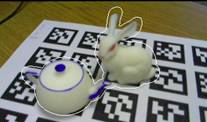Maria Engberg and Jay Bolter are guest editors of the February 2014 issue of the journal Convergence. They present a set of papers by eight media studies scholars and artists on the significance of AR and MR for cultural expression. Here is an excerpt from their opening editorial: The widespread availability of smart phones in …
Category: Publications
Oct 29 2008
Watercolor Inspired Non-Photorealistic Rendering for AR
Abstract Non-photorealistic rendering (NPR) is an attractive approach for seamlessly blending virtual and physical content in Augmented Reality (AR) applications. Simple NRP techniques, that use information from a single rendered image, have been demonstrated in real-time AR systems. More complex NRP techniques require visual coherence across multiple frames of video, and typical offline algorithms are …
Oct 08 2008
BragFish paper got accepted by ACE08
Congratulations~ I will attach the full paper and video later. Abstract: In this paper, we present our research on social interaction in colocated handheld augmented reality (AR) games. These games are characterized by shared physical spaces which promote physical awareness between players and individual gaming devices which support both public and private information. One result …
Mar 08 2008
Uncertainty Boundary for Complex Objects in AR
Abstract Registration errors between the physical world and computer-generated objects are a central problem in Augmented Reality (AR) systems. Some existing AR systems have demonstrated how to dynamically estimate registration errors based on estimates of spatial errors in the system. Using these error estimates, these systems also demonstrated a number of ways of ameliorating the …
Nov 01 2006
Supporting Early Design Activities for AR Experiences
Maribeth Gandy, Blair MacIntyre, Steven Dow, and Jay David Bolter. “Supporting Early Design Activities for AR Experiences” In Emerging Technologies of Augmented Reality, (B. Thomas, M.Billinghurst Ed.), Idea Group Publishing (2006).
Oct 06 2005
AR Karaoke: Acting in Your Favorite Scenes
Maribeth Gandy, Blair MacIntyre, Peter Presti, Steven Dow, Jay David Bolter, Brandon Yarbrough, and Nigel O’Rear. “AR Karaoke: Acting in Your Favorite Scenes” In The Fourth International Symposium on Mixed and Augmented Reality (ISMAR 2005), October 6-8, 2005, Vienna, Austria.
Oct 06 2005
Butterfly effect: an augmented reality puzzle game
Abstract Butterfly effect is a 3D puzzle game using augmented reality. The key motivation was to create a game that leverages the structure of the physical world during gameplay without requiring the computer to have a detailed model of the space. The butterflies are virtual, but the space the player navigates is physical. The player …
Oct 24 2004
DART: A Toolkit for Rapid Design Exploration of Augmented Reality Experiences
Blair MacIntyre, Maribeth Gandy, Steven Dow, and Jay David Bolter. “DART: A Toolkit for Rapid Design Exploration of Augmented Reality Experiences.” In Conference on User Interface Software and Technology (UIST’04), October 24-27, 2004, Sante Fe, New Mexico.
Oct 24 2004
DART: A Toolkit for Rapid Design Exploration of Augmented Reality Experiences
Abstract In this paper, we describe The Designer’s Augmented Reality Toolkit (DART). DART is built on top of Macromedia Director, a widely used multimedia development environment. We summarize the most significant problems faced by designers working with AR in the real world, and discuss how DART addresses them. Most of DART is implemented in an …
Oct 24 2004
DART: A Toolkit for Rapid Design Exploration of Augmented Reality Experiences.
Abstract In this paper, we describe The Designer’s Augmented Reality Toolkit (DART). DART is built on top of Macromedia Director, a widely used multimedia development environment. We summarize the most significant problems faced by designers working with AR in the real world, and discuss how DART addresses them. Most of DART is implemented in an …


Recent Comments